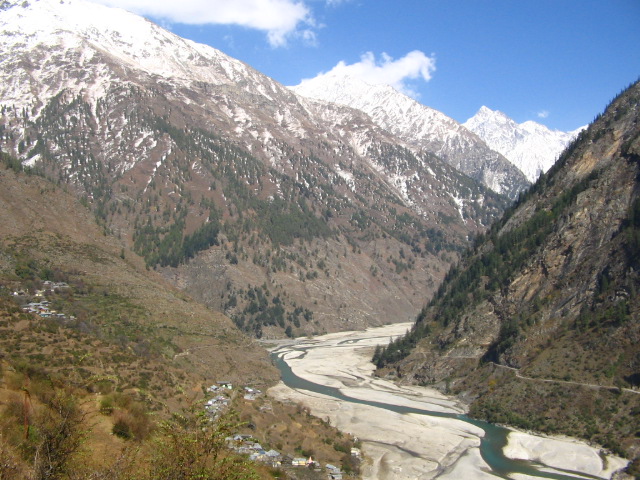National Environmental Engineering Research Institute (NEERI)
Drinking water treatment technologies - A handbook by National Environmental Engineering Research Institute & Ministry of Drinking Water and Sanitation
Posted on 30 Nov, 2012 10:22 PMThis handbook prepared by National Environmental Engineering Research Institute has eight chapters:
Chapter 1 introduces the objectives and approaches adopted to prepare the handbook.
Water quality of the Bhagirathi, Ganga in the Himalayan region: A study by NEERI
Posted on 19 May, 2012 05:00 PM The Bhagirathi in its upper reaches, here seen near Dharali (Photo: Chicu Lokgariwar)
The Bhagirathi in its upper reaches, here seen near Dharali (Photo: Chicu Lokgariwar)
Online survey by NEERI in cooperation with University of Liverpool on the functioning of the Environmental Impact Assessment (EIA) in India and the UK
Posted on 27 Jun, 2011 11:52 AMNational Environment Engineering Research Institute (NEERI) in association with University of Liverpool (UK) is conducting online survey on the functioning of the Environmental Impact Assessment (EIA) in India and the UK. The purpose of the survey is to reflect on the experiences of professionals with EIA in the past and also to look ahead to the future role of EIA.
The first three parts of the survey is based on what your experiences of EIA are while the fourth part relates to what EIA should be like. The survey is anonymous and completing it will take approximately 10 to 15 minutes of your time. Please note the ‘save’ option in the survey does not actually let you save and come back to the survey later.
Guidance manual for drinking water quality monitoring and assessment - A document by NEERI and NICD
Posted on 20 Apr, 2011 03:09 AMIn order to safeguard the health of the people, drinking water must meet quality standards. The main issues involved in drinking water safety are water quality management, surveillance and control mechanisms.
Levels of contaminants need to be ascertained through standard procedures. Each agency involved in water supply in India, has its own laboratory test practices and this manual details methods for all parameters adoptable by all laboratories.
Drinking water quality monitoring and development of surveillance mechanisms - A pilot study done by NEERI in New Delhi
Posted on 20 Apr, 2011 02:30 AMThe WHO guidelines for drinking water quality aim to protect public health and the key way to ensure this is through the adoption of Water Safety Plans (WSP). WSP includes setting of health targets, risk analysis and its assessment to identify priority hazardous scenarios and management of the risk.
Water safety plan: A manual for pilot study areas of Hyderabad
Posted on 20 Apr, 2011 02:03 AMThe most effective means of consistently ensuring the safety of drinking water supply is through the use of a comprehensive risk assessment and management approach, that encompasses all steps in water supply from catchment to consumer. Such approaches are called Water Safety Plans (WSPs).
The aim of a WSP is to organize and systematize records of management practices applied to drinking water and to ensure workability of such practices to organized drinking water supply.
Application of Composite Correction Program for improvement in efficiency of water treatment plants - A WHO paper
Posted on 20 Apr, 2011 12:41 AMThe goal of safe and affordable drinking water and sanitation has not yet been achieved. The current practices of water purification are inadequate to produce secured water supply. Maintaining health protection at water supply systems has become more challenging with resistance of some pathogens to disinfection using chlorination and an increase in the immuno-compromised population (e.g., people with HIV, organ transplant patients, the elderly).
In this context, it has become essential to develop various tools such as Composite Correction Programme (CCP) and Water Safety Plans (WSP) to improve water purification and distribution systems, to achieve the goal of providing safe drinking water.
Arsenic and chromium hyper-accumulation by an ecotype of Pteris vittata - Possibility of remediation of contaminated water and soil – A paper in Current Science
Posted on 14 Apr, 2011 08:04 PM This study by National Environmental Engineering Research Institute published in Current Science was carried out to identify Pteris vitta and test its hyper-accumulating properties. The plant is commonly known as the Ladder brake fern or Chinese brake fern plant in India, and had been reported elsewhere as an arsenic hyper-accumulator.
This study by National Environmental Engineering Research Institute published in Current Science was carried out to identify Pteris vitta and test its hyper-accumulating properties. The plant is commonly known as the Ladder brake fern or Chinese brake fern plant in India, and had been reported elsewhere as an arsenic hyper-accumulator.
.The remediation of arsenic and chromium contaminated soil and water has become an important environmental issue. It is in this context that the discovery of hyper-accumulator plant species, which have the unusual ability of accumulating metals such as arsenic (As), chromium (Cr), zinc (Zn), nickel (Ni) and copper (Cu) to very high concentrations, has further boosted technologies based on this property.
This is the first report of characterization of arsenic accumulation in an Indian ecotype (plant), which also shows chromium hyperaccumulation in addition to arsenic. Intact plantlets were grown in 20 per cent Hoagland solution amended with up to 200 mg arsenic or chromium medium. Plants absorbed and accumulated a significant amount of arsenic and chromium in their biomass with high bio-enrichment factor. Arsenic and chromium tolerance by spores and gametophytes under in-vitro was also assessed.
Brainstorming workshop on interface between water technology developers and other stakeholders by NEERI
Posted on 08 Oct, 2010 08:17 PMA workshop on developing interface between water technology developers and other stakeholders particularly those who actively address water policy issues namely officials of Department of Drinking Water and Sanitation, Public Health Engineering Department, NGOs, International Organisations and Professional Associations was held by the National Environmental Engineering Research Institute (NEERI) with support of the Department of Science and Technology (DST) at Nagpur on 7th September, 2010.